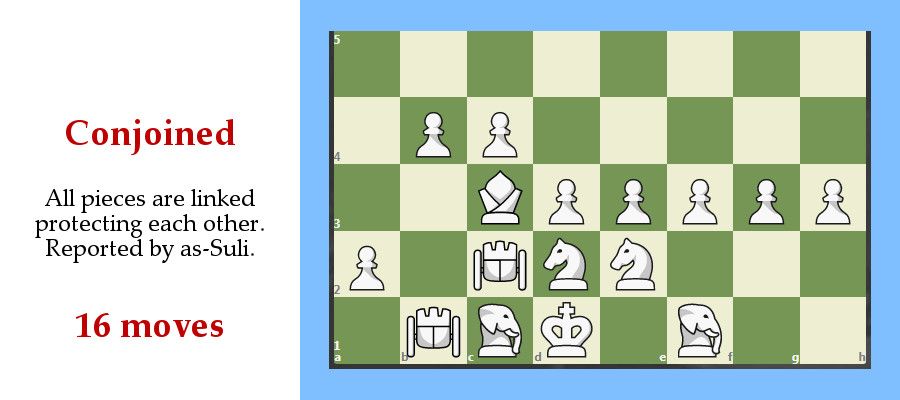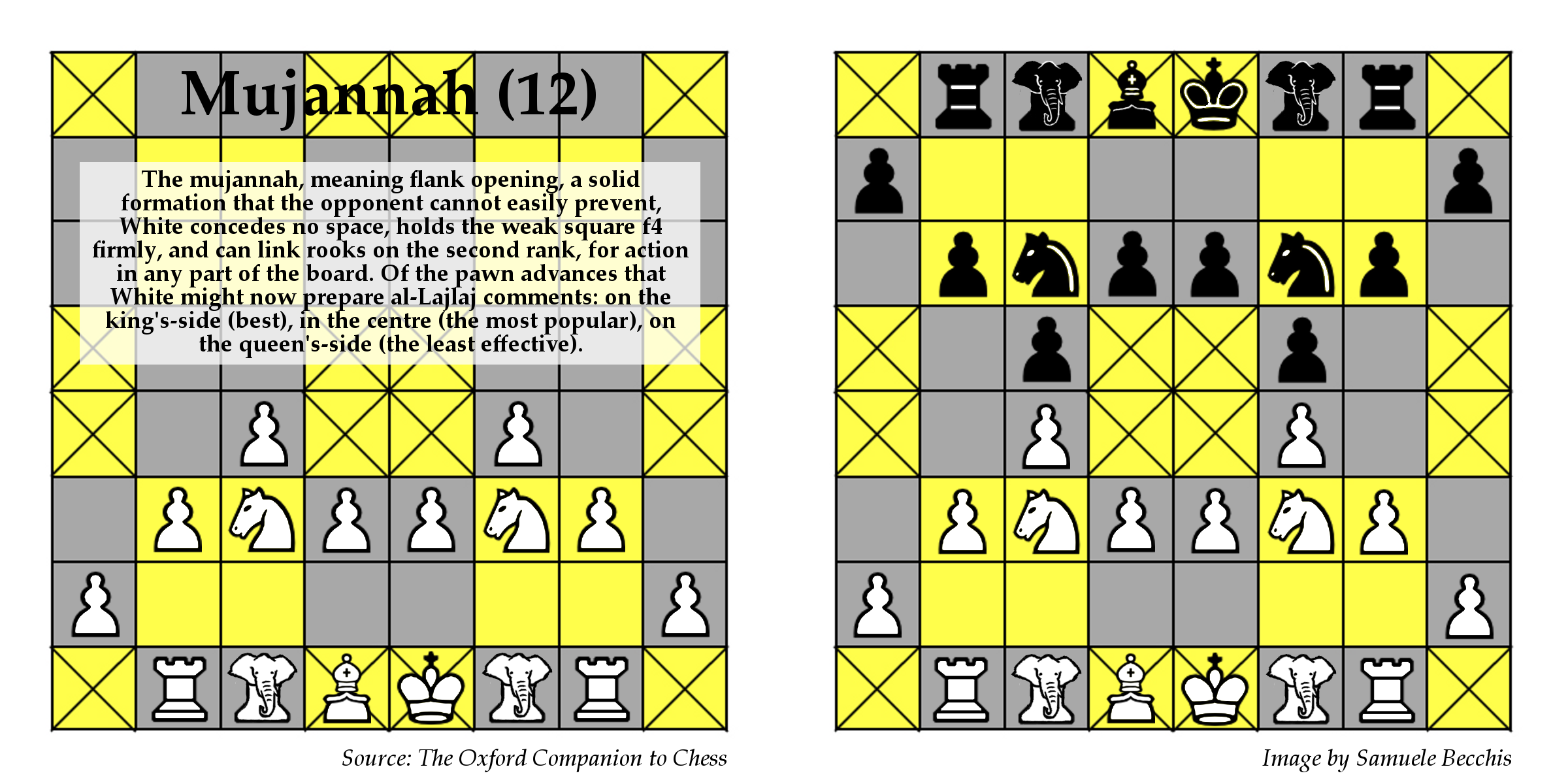16 tabiyat (opening systems)
Source: "A History of Chess" by H.J.R. Murray, published in 1913.
















16 tabiyat are too many! Each one has to be tried finding the best move orders, and each one has its own variations. You don't want to always complete the tabiya: your opponent can prevent you from that or can play so bad that allows you to do something even better. The tabiya has to be chosen and adapted to the game you are in.
I suggest to focus on 4 of them as a starting point. Four different conceptions of the game, I would say from most tactical to most positional, they are: Sayyal (or Sayyala), Mujannah, Mashaikhi and Saif (the sword opening).

They are shown paired together but they do not represent real game positions. 'Accidentally' both players have made 12 moves in the first diagram and both players have made 19 moves in the second diagram.
One of the greatest classic is the 'Mujannah Vs Mashaiki' opening. An interesting variation of it has been described by ChessStakhanov in the following video (in Russian language).
...
--o-o--
EDIT: On the same subject, other videos in English
Another interesting video, this time about the Muraddad tabiya, which is the opening system that I called Forth and Back in my first post above (2nd image in the list); and this is an English spoken video from Jonathan Hilton! ![]() Enjoy it:
Enjoy it:
Really a well detailed analysis, I hope you guys watch it till the end because it is really interesting and helpful for improvements.
---
Feel free to comment the linked videos directly on YouTube, this might increase the popularity of them.
Mujannah Vs Mujannah = the 'Double Mujannah' opening
2 complete video-analysis by KindlyCoach:
Plus 4 sample games with playlist index: 46, 47, 48 and 49
...
Here an old image made by me, showing the Mujannah and the Double Mujannah, unfortunately it was done with the Kings on the e-file (but nothing changes actually):

Shah-side attack Mujannah
As said by the above image, the Shah-side attack is the most efficent idea in the Mujannah tabiya, or at least it is so in 90% of cases. Well, so the most common way to continue, after the Mujannah completion, is given by the moves Rg2, then Rc2-or-Rgb2 (two different variations actually), followed (or preceded it's the same) by the pawn advance to a3 and b4, trying to achieve an outpost in c5 or b5. I think this image is clear:

The a3 square can controversially be occupied also by the shah Alfil to protect the sayyal pawn in c5, or possibly even to move to c5 so getting a 'Super-Elephant' outpost, or - also good - getting exchanged in c5 for two enemy pawns, the last usually happens with the help of a Knight in a4.
--o-o--
Unorthodox Mujannah
The maneuver required to move the ferz Rook to the shah-side is actually a bit slow, it has to be done in 3 moves: Rg1 - Rg2 - Rc2/b2. Someone in some cases prefers instead: h3 - Rh2 - Rc2/b2, with an apparent gain of tempo, because the Rook gets to the same square and the h-pawn advances by one.
However there's some risk that the gain of tempo actually becomes a loss of tempo, because the pawn in h3 might block the development of the ferz Alfil, be careful!
--o-- 8 mini tabiyat --o--
Now let's take a step back! I'm realizing that this list of 16 tabiyat isn't very useful, because it comes from ancient sources and probably ancient players had a different approach to the game than we have, especially in the opening phase.
I mean, in modern play you can see a lot of early attacks, so it's rare to complete a tabiya that takes 18, 19 or even 20 moves! So now I want to focus on very short 'mini tabiyat', which are probably more useful and inspiring. They have no names, actually the names given here are invented by me.
...
Always Good (4 moves)

The advance of the 4 central pawns. I play it almost always, I see everybody playing it and it's always good, hence the name. "Four pawn opening" is another possible and common name. It's a sort of universal start, which can become any of the most important tabiyat: Mujannah, Mashaikhi, Sayyal, Saif, Conjoined System, Forth and Back... Almost everything!
...
Room for Elephants (4 moves)

I have never played it and have seen nobody playing it, but I'm somehow confident that it's at least playable and can offer interesting development ideas. Not only those sort of ancient fianchettos (Aa3 and Ah3) but also Alfil attacks on b5 and g5, and even some 3rd rank Rook ideas! I called the previous one "Always Good", likely I should call this one "Why Not".
...
Computer Play (4 moves)

So far I have seen only computers playing this way, and very rarely some novices. I can't tell you what is the good part of it exactly, but then the computer beats me, so probably this opening has something good and perhaps I should call it "Not Completely Wrong".
...
6-Pawn Line-up (6 moves)

Can't find any better name for this. Again a universal start which keeps almost all doors open, while waiting for the opponent to mistake or commit. It can theoretically transpose into every tabiya shown above except for: Armpit Attack, All-Out Attack, Kirmani, Pharaoh Stones and Servant's Banner.
...
6 Pawns on the Shah-side (6 moves)

This one instead doesn't seem universal, even if in theory there are still many possibilities. It is the base for the Goat Peg tabiya - attacking the enemy on the Farzin-side - or equally could transpose into a Coolthing's Storm (which I'll describe later on) - attacking the enemy on the Shah-side.
...
6 Pawns on the Farzin-side (6 moves)

Much more common than the previous one, this is used in most of the cases to achieve a Sayyal tabiya or (less often) a Conjoined System. Again, many other possibilities are theoretically available from this position...
...
Half Mujannah (6 moves)

Once you have got the importance of the Shah-side attack in the Mujannah then it becomes almost natural to try to do the same by developing only the Shah-side pieces, so with no helps from the farzin-Rook, but much faster: only 6 moves. This can of course transpose into a standard Mujannah.
...
Accelerated Sayyal (6 moves)

An amazing tool that I have been trying out recently, ideal for an immediate attack on the Shah-side. I'd say stronger than the Half Mujannah, a real beginners destroyer! The great as-Suli knew it and played it with success (see this ancient game for example). It can't transpose into anything else, not even a standard Sayyal.
...
Well, that's all for now, thanks for reading. I'll add other stuff nextly... Meanwhile feel free to comment, critic and correct me where/if I am wrong.
Very enlightening content, thx.
It's easy to notice the huge difference in strategic thinking between Shatranj and Chess from the opening. I think the style of Shatranj's opening seems to be more similar to that of Shogi, aka "joban".
Very enlightening content, thx.
It's easy to notice the huge difference in strategic thinking between Shatranj and Chess from the opening. I think the style of Shatranj's opening seems to be more similar to that of Shogi, aka "joban".
Indeed, I think you are right, Lappland! Actually I rarely played Shogi in my life, but yes, I think in Shogi the opening is slow paced as it is in Shatranj. It's cool because the rithm of the game accelerates little by little, it is not an immediate fight (like in Chess or XiangQi).
i play Computer Play (4 moves)
Even ChessStakhanov plays it... And sometimes he even manages to win!!
https://youtu.be/UuAQTckyEqc?si=N7_7uVIVcdEagDdM
So I will not call it "Computer Play" anymore, I will just call it the "Not Wrong" opening.
Not only Mujannah (winged) and Mashaikhi (sheikh's) but 16 of them